Ultimate Guide to Durable Sensor Materials for Gardens
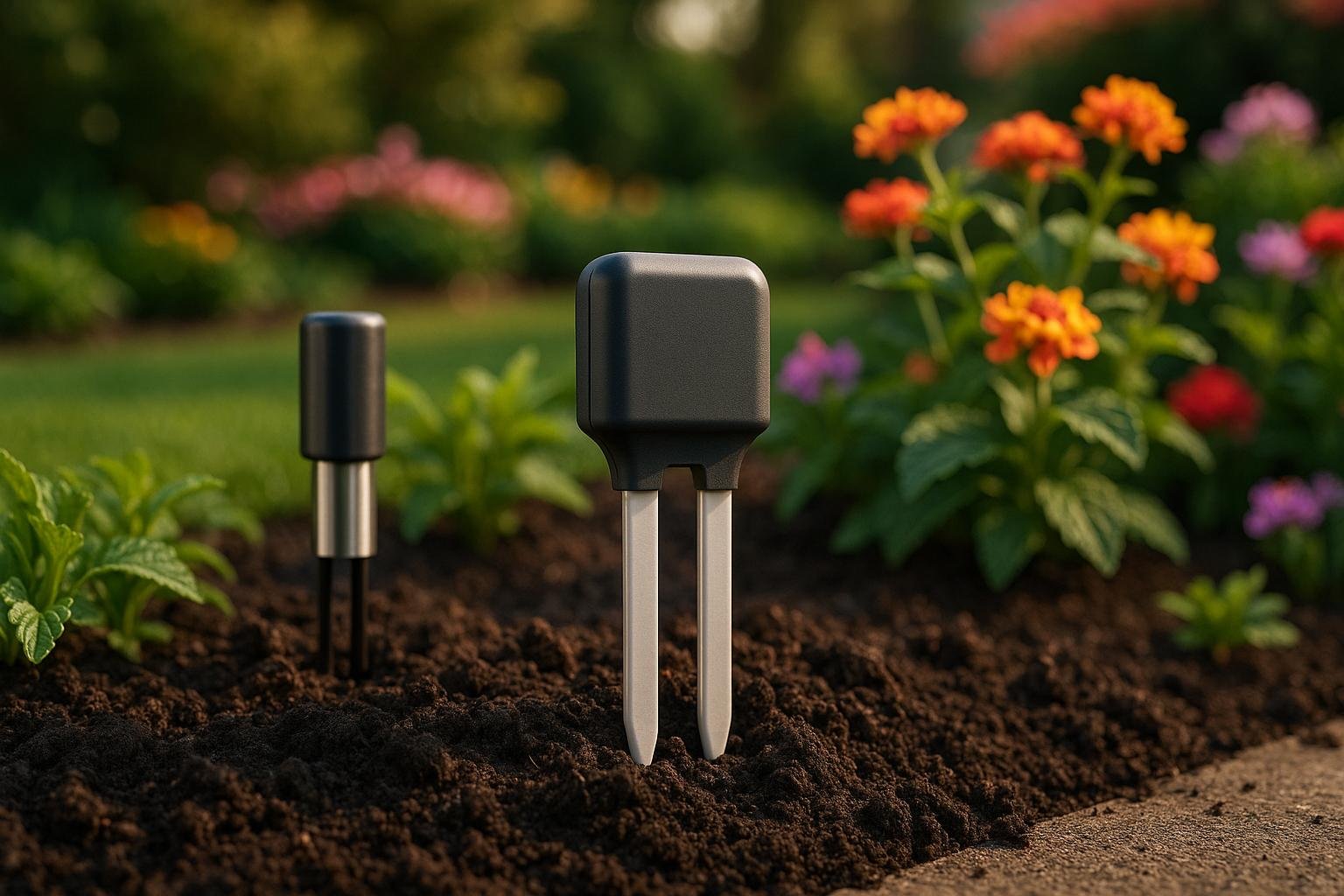
Want sensors that last in your garden? Here’s the quick answer: Durable materials like stainless steel, polycarbonate, ABS plastics, ceramic composites, and waterproof coatings can handle tough outdoor conditions like extreme temperatures, moisture, and UV rays. They ensure accurate data, longer lifespan, and better water management.
Why it matters:
- Save money: Durable sensors last 5+ years, cutting replacement costs.
- Reliable performance: Withstand rain, snow, heat, and corrosion.
- Conserve water: Smart sensors reduce water use by up to 40%.
Key materials to know:
- Stainless Steel: Corrosion-resistant, long-lasting.
- Polycarbonate/ABS Plastics: Lightweight, impact-resistant, affordable.
- Ceramic Composites: Ideal for soil chemistry sensors, highly durable.
- Waterproof Coatings: Protect electronics from water damage.
Quick Comparison Table:
| Material | Durability & Resistance | Temperature Tolerance | Key Features |
|---|---|---|---|
| Stainless Steel | Excellent corrosion resistance | Handles harsh environments | Fully recyclable, protects electronics |
| Polycarbonate | Strong, lightweight | –40°F to 248°F | Impact-resistant, affordable |
| Ceramic Composites | High mechanical strength | Stable in extreme heat | Great for chemically active environments |
Next steps: Assess your garden’s climate, plant needs, and system compatibility to choose the right material. Durable sensors are the backbone of efficient, low-maintenance gardening.
GS3 Greenhouse Sensor
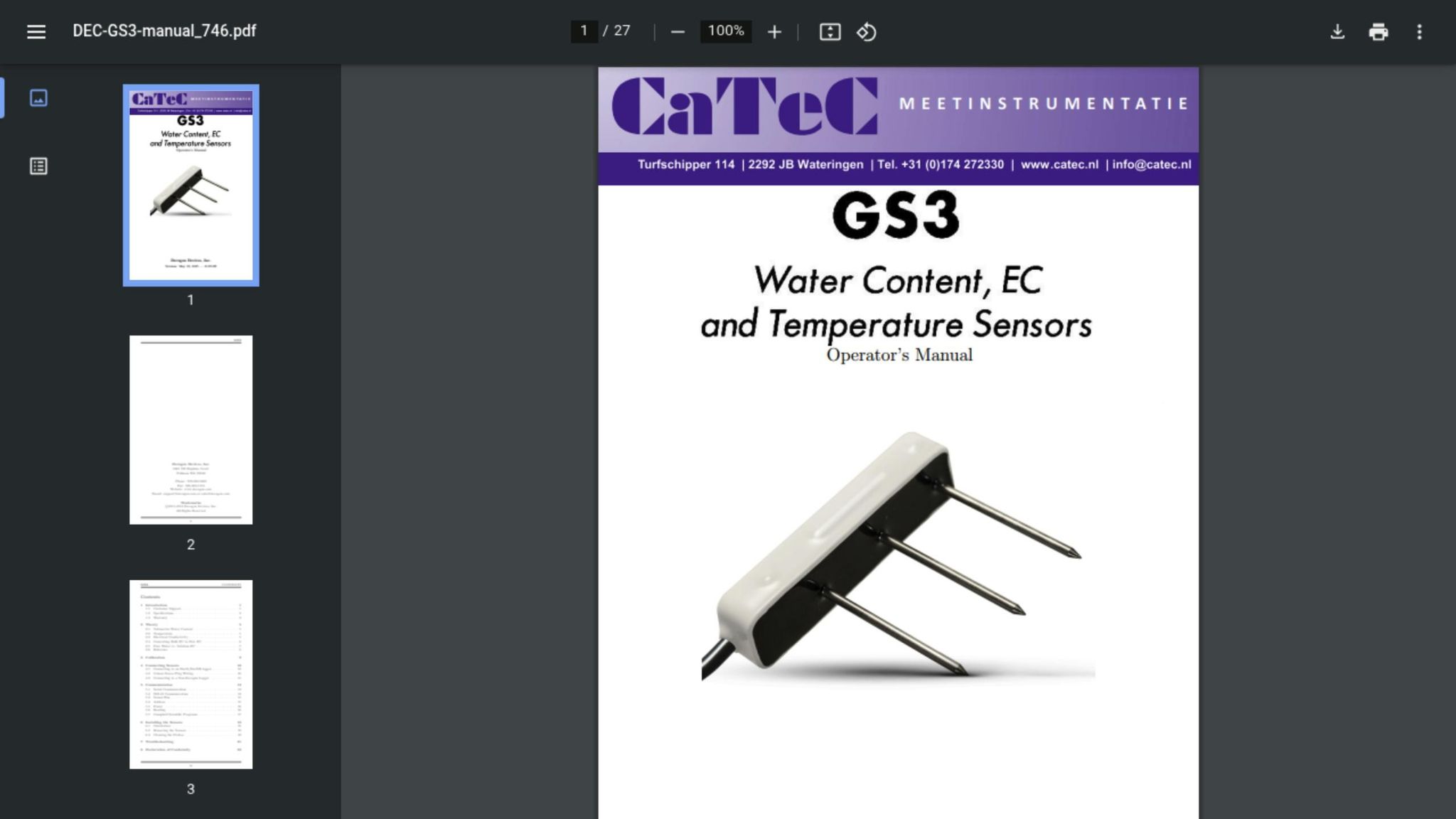

Main Types of Durable Sensor Materials
When it comes to smart gardening, the materials used in sensors play a key role in ensuring they can withstand the elements. Materials like stainless steel, engineered plastics, and ceramic composites are designed to handle moisture, temperature swings, and constant outdoor exposure, making them essential for reliable performance.
Stainless Steel and Its Applications
Stainless steel is a go-to material for sensor components, thanks to its impressive strength, durability, and resistance to corrosion and staining. These qualities make it especially useful in environments where cleanliness and durability are non-negotiable. In smart gardening, stainless steel ensures sensors can consistently deliver accurate readings, even in tough conditions.
Polycarbonate and ABS Plastics
Polycarbonate and ABS plastics are widely used for sensor housings because they strike a balance between durability, cost, and weight.
- Polycarbonate is known for its ability to handle high impacts and extreme heat, making it ideal for sensors exposed to intense sunlight or rapid temperature changes.
- ABS plastic provides a more budget-friendly option while still offering strong weather resistance. Many ABS formulations are designed for outdoor use, featuring UV and scratch resistance to maintain their integrity over time .
Blending polycarbonate and ABS creates a material that combines the strengths of both - excellent impact resistance, chemical durability, and design flexibility. For example, polycarbonate's transparency is perfect for sensors with visual indicators, while ABS's opaque nature works better for light-sensitive applications. Both materials can be molded into intricate shapes, enabling compact and efficient designs that hold up in demanding gardening environments.
Ceramic Composites and Waterproof Coatings
Ceramic composites shine in chemically active settings, such as when sensors monitor soil chemistry or nutrient levels. Unlike metals, ceramics are immune to corrosion from fertilizers, pesticides, and natural soil acids, making them a dependable choice for these tasks.
To protect electronic components from water damage, waterproof coatings like epoxy-based sealants or polyurethane coatings are used. These coatings create a watertight barrier, allowing sensors to achieve IP67 or IP68 ratings. This level of protection ensures sensors can function even in extremely wet conditions, such as heavy rain or submersion. Together, ceramic composites and waterproof coatings provide the reliability needed for sensors to thrive in challenging environments, as explored further in the next section.
Benefits of Weather-Resistant Sensor Materials
Weather-resistant sensor materials transform delicate sensors into dependable tools, ensuring they perform effectively in tough outdoor environments. They also offer long-term value, particularly for gardeners and those managing irrigation systems.
Improved Sensor Reliability and Performance
Sensors built with weather-resistant materials deliver accurate readings regardless of the conditions. They can handle extreme temperatures, heavy rain, UV exposure, dust, and debris, making them reliable in everything from scorching summers to freezing winters or downpours. This durability ensures consistent functionality even when the environment gets challenging.
Additionally, these materials extend the lifespan of sensors. Corrosion-resistant options like stainless steel or epoxy-sealed electronics protect internal components from moisture and chemical damage. Sensors with rugged enclosures and high IP ratings (like IP64, IP65, or IP67) offer robust defense against dust and water. This not only enhances performance but also reduces the need for frequent replacements, saving time and money in the long run.
Cost Savings from Extended Lifespan
Choosing sensors made with weather-resistant materials can significantly cut costs over time. While standard sensors might need replacement every 1–2 years, more durable options can last over five years. This longevity adds up to savings, considering the costs: soil moisture sensors range from $99 to $165, wireless rain sensors from $120 to $200, and wired rain sensors from $30 to $50.
For areas with harsh winters, frost-resistant models or seasonal removal and storage are often recommended. However, sensors built with weather-resistant materials may eliminate the need for seasonal storage altogether, further simplifying maintenance.
Enhanced Water Conservation and Efficiency
By ensuring reliable performance, weather-resistant sensors play a vital role in water conservation - an essential aspect of smart irrigation. Accurate data from these sensors allows irrigation systems to optimize water usage. For example, commercial soil moisture sensors can reduce water consumption by 20–30%. Traditional irrigation methods often waste up to 50% of water due to evaporation, runoff, and overwatering, but sensor-based systems can cut water waste by 20–50% while boosting plant health and crop yields.
Different sensor types contribute uniquely to water savings:
- Weather-based sensors can save up to 30% more water compared to timer-based systems.
- Rain sensors reduce annual water use by 15–25%.
- Plant-based moisture sensors can decrease water consumption by up to 40%.
Real-world examples highlight these benefits. In Las Vegas, Nevada, homes using ET-based controllers saw a 20% reduction in irrigation compared to homeowner-scheduled systems. Another study on St. Augustine turfgrass showed a 43% average irrigation savings during summer with ET controllers, maintaining turfgrass quality. Soil moisture controllers achieved an average of 72% irrigation savings and a 34% reduction in water use during drought conditions compared to traditional irrigation schedules.
These water-saving advantages are only possible when sensors deliver consistent, accurate data. Weather-resistant materials ensure sensors remain reliable, providing the critical information smart irrigation systems need for effective water management.
sbb-itb-4d6a8dd
🚀 Ready to Reinvent Your Garden?
Join thousands of homeowners who have transformed their gardens using our AI design tool. Upload one photo to explore endless possibilities.
Get your AI garden designs →How to Choose the Right Sensor Material for Your Garden
Picking the right sensor material for your garden is more than just a technical decision - it’s about ensuring your plants thrive while minimizing maintenance and costs. Using unsuitable materials can lead to frequent replacements, unreliable readings, and unnecessary expenses. Here’s how to make a smart choice tailored to your garden’s needs.
Consider Climate and Weather Conditions
Your local climate heavily influences which sensor materials will work best. Sensors need to handle both scorching summers and freezing winters. For temperature sensors, look for high accuracy (about ±1°C) and housings that resist UV damage, especially if your garden gets a lot of direct sunlight.
Outdoor sensors must also be water- and dust-resistant. Check for devices with solid IP ratings like IP64, IP65, or IP67 to guard against rain, snow, and dirt. Regular cleaning is crucial to keep them functioning well over time.
Evaluate Garden Size and Plant Needs
The layout of your garden and the plants you grow will shape your choice of sensor material. For soil moisture sensors, the probe length should match the root depth of your plants - shorter probes for shallow-rooted plants and longer ones for deeper roots.
Capacitive sensors are a good all-around option because they avoid exposed metal parts that can rust, making them reliable across various soil types. On the other hand, TDR sensors provide excellent accuracy without frequent calibration, though they tend to cost more and have a smaller sensing area.
Different garden zones may require different sensor types. For example, vegetable gardens might need corrosion-resistant probes for constant soil contact, while flower beds might benefit from sensors designed for varied soil textures. And don’t forget to check how well the sensor integrates with your smart gardening system.
Compatibility with Smart Gardening Systems
Durable materials are important, but seamless connectivity is just as crucial for managing a smart garden. Ensure the sensor works with your existing setup by supporting the right connectivity protocols.
Many sensors are compatible with platforms like Google Home, Amazon Alexa, or Apple HomeKit, allowing for voice control and automation. Zigbee 3.0 is a popular choice for broad integration options. For instance, the ThirdReality Smart Soil Moisture Sensor works with Home Assistant, Hubitat, and SmartThings systems. If your garden is large or the sensors are far from your central hub, consider adding Zigbee repeaters (like smart plugs or bulbs) to extend the signal range.
Battery life is another key factor for wireless sensors. Look for weather-resistant housings that protect batteries from extreme temperatures, as this can extend their lifespan and reduce how often you need to replace them. Some sensors even report battery levels to connected apps, helping you plan replacements and avoid disruptions.
Before making a purchase, review the manufacturer’s specifications to confirm compatibility with your current system and any future upgrades. For a more comprehensive approach to garden planning, tools like AIGardenPlanner can help you decide the best sensor placement and provide tailored plant recommendations based on your local climate and preferences.
Comparing Popular Durable Sensor Materials
This review dives into the unique qualities of different sensor materials, helping you pick the right one for your garden. By understanding the strengths of each material, you can make smarter choices for your gardening needs.
Comparison Table of Sensor Materials
| Material | Durability & Resistance | Temperature Tolerance | Key Features |
|---|---|---|---|
| Stainless Steel | Exceptional durability and corrosion resistance | Performs well in harsh environments | Fully recyclable; ideal for protecting electronics in tough outdoor settings |
| Polycarbonate | Strong durability and chemical resistance | Handles –40°F to 248°F (–40°C to 120°C) | Lightweight, affordable, impact-resistant (up to 900 lbs); versatile designs |
| Ceramic Composites | High durability with advanced mechanical strength | Excellent stability at high temperatures | Combines ceramic and fiber for extreme conditions; great for specialized uses |
Each material in this table brings distinct advantages, allowing you to tailor your sensor choice to your garden's environment.
Stainless Steel stands out for its unmatched durability and corrosion resistance, making it a top pick for harsh outdoor conditions. Plus, its 100% recyclability is a bonus for those who prioritize eco-friendly options.
Polycarbonate offers a practical mix of durability and affordability. Not only is it lightweight and easy to work with, but it also boasts impressive impact resistance - about 30 times stronger than acrylic and 250 times stronger than glass. This makes it ideal for areas where strength and transparency are important.
Ceramic Matrix Composites (CMCs) are a high-tech solution for extreme conditions. By combining ceramic properties with fiber reinforcement, CMCs deliver reliable performance where traditional materials might fail. They're perfect for specialized applications requiring high-temperature stability and mechanical strength.
Use the table and material insights to align your sensor choice with your garden's specific needs. For gardens exposed to harsh weather, stainless steel or ceramic composites may offer the durability needed. Meanwhile, polycarbonate suits situations where cost and ease of use are priorities.
Selecting the right material enhances sensor performance and supports efficient water management. Tools like AIGardenPlanner can help you optimize sensor placement based on your local climate and plant needs, ensuring you get the best results for your garden setup.
Conclusion and Key Takeaways
Why Durable Sensors Matter
Investing in durable sensor materials can transform the way you care for your garden. Let’s break down the key advantages that make this choice a smart one for any dedicated gardener.
- Save money in the long run: Durable sensors mean fewer replacements, which translates to lower costs over time.
- Reliable performance: Weather-resistant designs with strong waterproofing and corrosion protection ensure your sensors keep delivering accurate data, even in tough conditions.
- Conserve water: Smart sensors can help cut garden water usage by up to 40% each year. By precisely monitoring soil moisture, they prevent overwatering and protect your plants from drought stress.
These benefits not only streamline garden care but also pave the way for smarter, more efficient garden management.
Steps to Get Started
Ready to level up your gardening game? Here’s how to put these benefits into action.
- Assess your garden’s needs: Take stock of your soil, light, and water conditions. This will help you decide which sensor materials are best suited for your setup.
- Start small: Test the waters by installing a single smart sensor in a small section of your garden. This lets you learn the ropes without a big upfront cost.
- Do your homework: Before buying, check product specs and read user reviews. Look for sensors built with weather-resistant materials to ensure they can handle the elements.
- Strategically place your sensors: Install them where they’ll provide the most benefit while keeping your garden’s aesthetic intact.
- Use tools like AIGardenPlanner: This AI-powered platform can help you map out the best spots for your sensors based on your garden’s layout, local climate, and plant needs.
Finally, remember that gardening with smart sensors is a journey. Be patient as you experiment with settings, and don’t hesitate to tap into online resources or gardening communities for advice. The effort you put in now will reward you with healthier plants and more efficient resource use for years to come.
FAQs
How can I choose the right sensor material for my garden's climate and plants?
To pick the right sensor material for your garden, start with capacitive sensors. These are known for their accuracy and tend to perform better in different soil types, as they're less impacted by factors like soil salinity or composition. This makes them a reliable choice for precise monitoring.
For even better performance, opt for sensors that can measure multiple elements such as moisture, temperature, and light levels. This way, you'll have a clearer picture of your garden's environment and can cater to your plants' specific needs. Don't forget to prioritize durable, weather-resistant materials to ensure your sensors can handle outdoor conditions over time.
What are the advantages of using weather-resistant sensor materials over standard ones in terms of cost and performance?
Weather-resistant sensor materials are built to handle tough outdoor environments, standing up to extreme temperatures, heavy rain, and high humidity. This durability ensures they deliver consistent, accurate readings without the need for constant replacements.
Although they might cost a bit more upfront, their lower maintenance requirements and extended lifespan make them a smart investment. For gardeners, this translates to fewer hassles and more reliable data to keep your garden flourishing.
How do waterproof coatings improve the performance and lifespan of garden sensors in rainy or wet conditions?
Waterproof coatings are essential for shielding garden sensors from moisture and water damage. These coatings act as a protective layer, keeping water from penetrating the sensor's internal parts. This helps prevent corrosion and ensures the sensor remains accurate, even in persistently damp conditions.
With this extra layer of defense, the lifespan of garden sensors is noticeably prolonged, allowing them to stay dependable and effective during rainy periods or in humid climates. Choosing sensors with waterproof coatings is a practical move for gardeners who need consistent and precise monitoring, no matter the weather.
🎨 Visualize Your Dream Garden Today!
Transform any outdoor space into a professional landscape design in minutes. Just upload a photo, choose your style, and let our AI do the rest.
Start your garden transformation now →Related posts
Related Articles

How AI Matches Colors and Textures in Gardens
Explore how AI simplifies garden design by matching colors and textures, creating personalized layouts for thriving outdoor spaces.
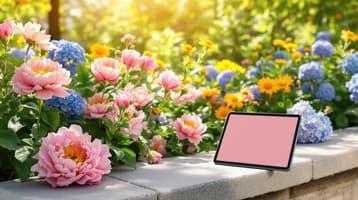
How AI Picks Garden Color Schemes
AI tools transform garden design by analyzing photos to create customized color schemes, considering local climate and personal preferences.
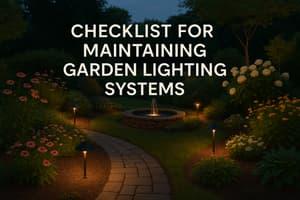
Checklist for Maintaining Garden Lighting Systems
Learn essential tips for maintaining your garden lighting system, ensuring safety and aesthetics throughout the seasons.
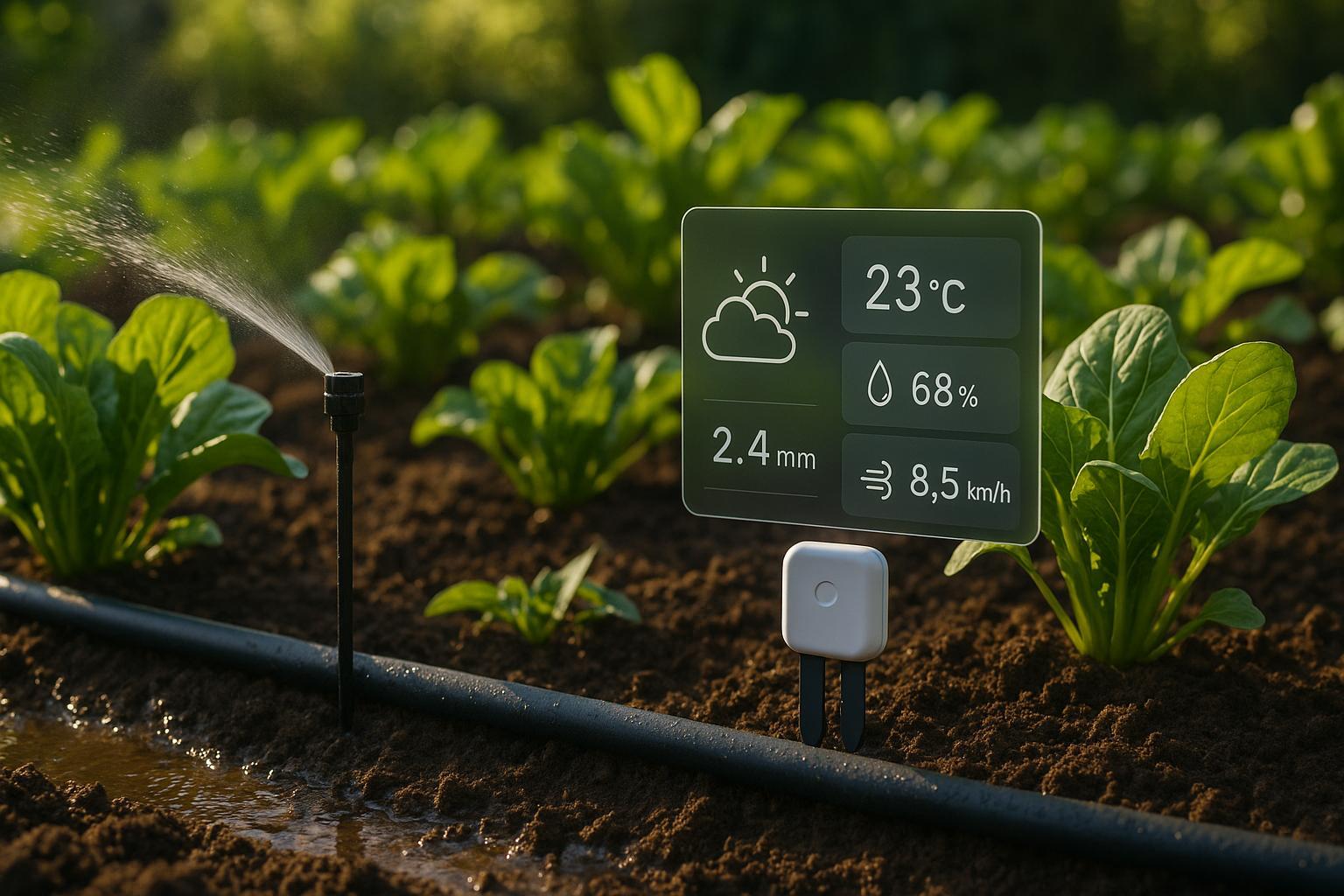
How AI Analyzes Irrigation System Compatibility
Explore how AI optimizes irrigation systems by analyzing soil, weather, and plant data, leading to efficient water use and healthier gardens.

The Benefits of Planning a Garden: Tips for Creating Your Garden Plan
Learn about the benefits of garden planning and how to create a garden plan that works for you. Discover how to choose the right plants, maximize productivity, and control pests and diseases.

5 Solutions for Common Garden Design Challenges
Explore innovative solutions for common garden design challenges, from vertical gardens to AI-driven soil improvements and weather-smart planning.